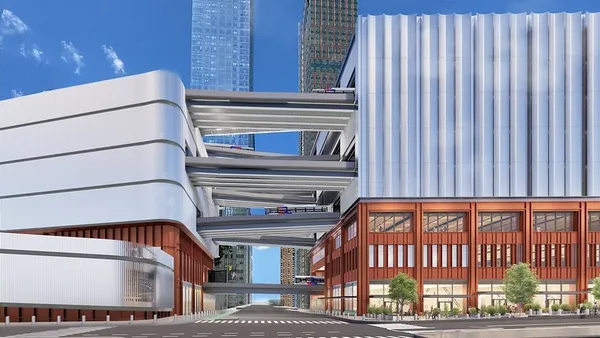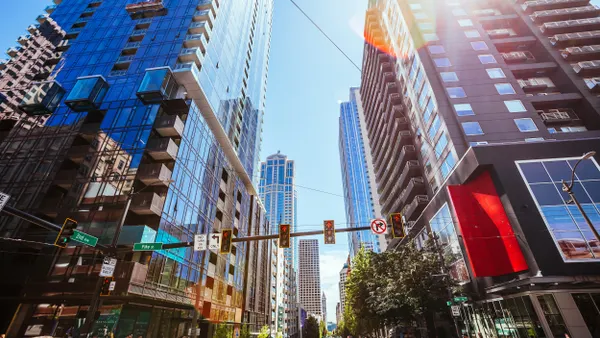Dive Brief:
- Bloomberg Philanthropies has launched the Asphalt Art Initiative in response to the growing number of cities that are embracing public art as a way to improve street safety, revitalize public spaces and engage communities.
- The organization released a free guide highlighting cities that successfully incorporated art into roadways, plazas or other infrastructure, as well as tips for cities to develop such projects.
- Bloomberg Philanthropies will award grants of up to $25,000 to 10 small and mid-sized U.S. cities (populations of 35,000 to 500,000) to support asphalt art projects. Applications are due Dec. 12 and winners will be announced next spring.
Dive Insight:
Installing art on asphalt infrastructure is a growing trend, as cities and their partners paint creative crosswalks to enhance public space and promote safety. The creative designs are said to catch drivers' attention which makes them slow down and be more cognizant of pedestrians in the crosswalk. The safety idea prompted Medford, MA to add a crosswalk near an elementary school that is painted to look like it is 3D, or floating.
Not every municipality is in favor of crosswalk art, though. Cincinnati recommended against using 3D crosswalks, citing guidance from the Federal Highway Administration (FHWA) that says the infrastructure art can lead to unsafe driver behaviors such as swerving. FHWA has criticized cities that allow creative crosswalks, recently asking leaders in Ames, IA to remove new, brightly-painted "inclusive" crosswalks. The agency reportedly cited its rule that any paint other than white is not allowed in crosswalks, per the Manual on Uniform Traffic Control Devices (MUTCD).
Despite FHWA's pushback on creative crosswalks, cities continue to introduce them. Some leaders point to them — and other asphalt art — as low-cost, effective measures to beautify a city as well as inspire and engage citizens. Asphalt art can serve as municipal branding and highlight a city's history. Such projects have been said to revitalize neighborhoods and contribute to economic activity growth.
"When we combined our public art projects with our efforts to strengthen city infrastructure, through new public plazas or bike lanes, we created even safer, more vibrant streets for everyone. Now, we're working to share our experience and enliven streets and plazas around the world," said Michael Bloomberg, Bloomberg Philanthropies founder and former New York City mayor, in a statement.
The new guide book and grants encourage cities to undertake projects in crosswalks or intersections as well as in plazas or on vertical infrastructure such as underpasses, traffic barriers and utility boxes. The initiative has the potential to spur cities to more closely work with artists on creative and engaging transportation infrastructure design from project outset.
Cities that win the grants will have until the end of 2020 to complete their asphalt art projects.










